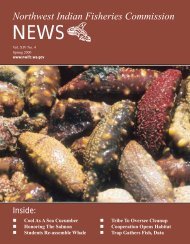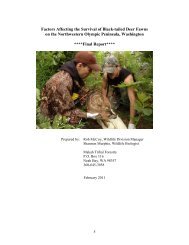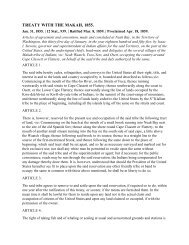NWIFC News - NWIFC Access - Northwest Indian Fisheries ...
NWIFC News - NWIFC Access - Northwest Indian Fisheries ...
NWIFC News - NWIFC Access - Northwest Indian Fisheries ...
You also want an ePaper? Increase the reach of your titles
YUMPU automatically turns print PDFs into web optimized ePapers that Google loves.
Squaxin Island Tribe:<br />
Willow Sticks Help Establish Habitat<br />
Sticks in the ground are helping restore streamside<br />
vegetation along Skookum Creek on the Squaxin<br />
Island Tribe’s reservation.<br />
“It won’t look like much because all the passers-by<br />
will see are thousands of willow stakes in the ground,<br />
but these cuttings will grow into willow trees themselves,”<br />
said Sarah Haque, habitat biologist for the<br />
Squaxin Island Tribe.<br />
“Branches from most species of willow, such as<br />
Sitka willow, easily take root, so a willow grove will<br />
soon surround the newly constructed logjams, creating<br />
habitat for salmon,” said Haque.<br />
The tribe constructed a series of logjams along<br />
Skookum Creek to slow the creek and provide<br />
salmon habitat.<br />
“Fast, straight streams aren’t good habitat for salmon,”<br />
said John Konovsky, environmental program<br />
manager for the tribe. “Juvenile and adult salmon<br />
need slow water so they can rest and feed.”<br />
“It isn’t enough just to put trees in the creek,”<br />
Konovsky said. “We need to grow a healthy forest<br />
around the creek, to make sure there will always be<br />
trees.”<br />
Ease of planting and the ability to root quickly make<br />
willow a good choice for salmon restoration projects<br />
with limited resources.<br />
“Salmon restoration money is limited, so we try to<br />
get the most out of the money we have,” said Andy<br />
Whitener, natural resources director for the tribe.<br />
Another benefit to the project is that the fully grown willow<br />
trees won’t grow tall enough to interfere with high-tension<br />
power lines that cross the area.<br />
“We have to work with what we’ve got and still restore the<br />
riparian area, which is why we chose to use low-growing<br />
willow species and dogwood to revegetate this stretch of the<br />
creek,” said Haque.<br />
The restoration project will especially benefit coho salmon,<br />
which spend more time in freshwater as juveniles.<br />
“Coho over-winter, which means they spend an extra year<br />
in freshwater,” said Konovsky.<br />
“They have more needs than other species of salmon<br />
for food and shelter in freshwater. Streamside shade and<br />
habitat features such as logjams give them what they need<br />
to survive.”<br />
South Sound wild coho populations have been declining<br />
steadily for more than a decade.<br />
“We need to continue repairing the habitat these fish need<br />
to survive,” said Whitener.<br />
– E. O’Connell<br />
Joe Peters, a fisheries biologist with the Squaxin Island Tribe, plants willows<br />
as part of a restoration project along Skookum Creek.<br />
Photo: E. O’Connell<br />
Sitka Willow Fast Facts<br />
• Of the more than 350 varieties of willow tree<br />
worldwide, Sitka willow is one of four native<br />
willow species that are common to the Puget<br />
Sound region.<br />
• Latin name: Salix sitchensis<br />
• Blooms are cream to yellow in color and up<br />
to 2 to 3 inches long.<br />
• Sitka willows are usually found near water,<br />
such as creeks and lakes.<br />
• They range from San Luis Obispo County,<br />
Calif., north to the Alaska panhandle and as<br />
far east as Idaho.<br />
• They can grow anywhere from 3 to 25 feet<br />
tall and up to 12 inches in diameter.









